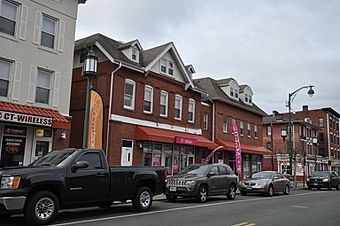Frog Hollow, Hartford, Connecticut facts for kids
|
Frog Hollow
|
|
 |
|
| Location | Roughly bounded by Park River, Capitol Ave., Oak, Washington, and Madison Sts. and Park Ter., Hartford, Connecticut |
|---|---|
| Area | 159 acres (64 ha) (original size) 9 acres (3.6 ha) (size of 1984 increase) |
| Built | 1850 |
| Architect | George Keller, et al. |
| Architectural style | Queen Anne, Italianate, Greek Revival |
| NRHP reference No. | 79002635 (original) 84001005 (increase) |
Quick facts for kids Significant dates |
|
| Added to NRHP | April 11, 1979 |
| Boundary increase | March 1, 1984 |
Frog Hollow is a historic and lively neighborhood in Hartford, Connecticut. It's known for its past as a busy industrial area and its many older homes. This neighborhood was mostly built between the 1850s and 1930s. Today, it still has lots of original buildings from that time. The entire Frog Hollow area, which is over 150 acres (61 ha), is listed on the National Register of Historic Places. This means it's a special place with important history!
Contents
Discovering Frog Hollow
Why is it Called Frog Hollow?
Frog Hollow got its name from the wet, marshy land that used to be here. This was especially true near what is now Broad and Ward streets. Imagine a place where frogs might have loved to hang out!
From Farmland to Factories
For a long time, Frog Hollow was mostly farmland. But that changed in 1852 when the Sharps Rifle Manufacturing Company built a factory. This started the area's journey into becoming a major industrial center. Sharps chose this spot because a railroad line had been built nearby in 1838.
After the Sharps Rifle Company closed in 1870, the Weed Sewing Machine Company took over the factory. It quickly grew to be even bigger than the famous Colt Armory in nearby Coltsville.
The Bicycle Boom
In 1876, a man named Albert Pope saw a cool high-wheel bicycle from Britain. He decided to start making bicycles in the United States. Pope asked George Fairfield of Hartford to help. The Weed Sewing Machine Company then made Pope's first bicycles in 1878.
Bicycles became super popular! Production at the Weed factory grew, and by 1890, bicycles were more in demand than sewing machines. That year, Pope bought the Weed factory and renamed it the Pope Manufacturing Company.
Early Cars and a Special Park
The bicycle craze didn't last forever. More and more people wanted cars. Pope's company faced money troubles because they made too many bicycles. To save his business, Pope started making electric cars in 1897. His company made the "Mark III" electric car.
Pope's efforts might have made Hartford a car-making capital! But other car makers, like Henry Ford, became very successful. After his business faced challenges, Pope gave a large piece of land to the community. This 75-acre (300,000 m2) park still provides a place for families to relax and play today.
A Community Hub
Park Street in Frog Hollow is sometimes called "New England's Spanish Main Street." This is because many people of Puerto Rican heritage live and have businesses there.
Years ago, there were plans to improve the area around Park Street and Main Street. The idea was to attract new businesses and create a big town square. These plans were later put on hold during a tough economic time.
Frog Hollow is also home to many important places. These include the Hartford Superior Court, Trinity College, The Learning Corridor, Hartford Hospital, and Connecticut Children's Medical Center.
Homes in Frog Hollow
People started building homes in Frog Hollow around 1850. The first homes were Greek Revival style houses. Later, Italianate style homes were built, including many duplexes (homes for two families).
The biggest building boom happened between 1890 and 1910. Lots of houses, schools, churches, and shops were built then. Many of these were multi-family homes. A special type of building called a "perfect six" became popular. These were three-story wooden buildings with two apartments on each floor. Many triple deckers, which have one apartment per floor, were also built.



